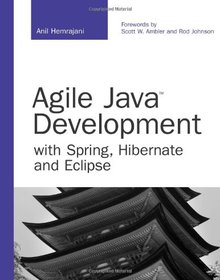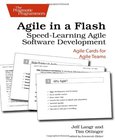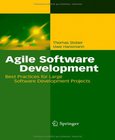Agile Java Development
With Spring, Hibernate and Eclipse

Book Details:
| Publisher: | Sams Publishing |
| Series: | Sams |
| Author: | Anil Hemrajani |
| Edition: | 1 |
| ISBN-10: | 0672328968 |
| ISBN-13: | 9780672328961 |
| Pages: | 360 |
| Published: | May 19 2006 |
| Posted: | Nov 19 2014 |
| Language: | English |
| Book format: | CHM |
| Book size: | 12.56 MB |
Book Description:
Agile Java Development With Spring, Hibernate and Eclipse is a book about robust technologies and effective methods which help bring simplicity back into the world of enterprise Java development. The three key technologies covered in this book, the Spring Framework, Hibernate and Eclipse, help reduce the complexity of enterprise Java development significantly. Furthermore, these technologies enable plain old Java objects (POJOs) to be deployed in light-weight containers versus heavy-handed remote objects that require heavy EJB containers. This book also extensively covers technologies such as Ant, JUnit, JSP tag libraries and touches upon other areas such as such logging, GUI based debugging, monitoring using JMX, job scheduling, emailing, and more. Also, Extreme Programming (XP), Agile Model Driven Development (AMDD) and refactoring are methods that can expedite the software development projects by reducing the amount of up front requirements and design; hence these methods are embedded throughout the book but with just enough details and examples to not sidetrack the focus of this book. In addition, this book contains well separated, subjective material (opinion sidebars), comic illustrations, tips and tricks, all of which provide real-world and practical perspectives on relevant topics. Last but not least, this book demonstrates the complete lifecycle by building and following a sample application, chapter-by-chapter, starting from conceptualization to production using the technology and processes covered in this book. In summary, by using the technologies and methods covered in this book, the reader will be able to effectively develop enterprise-class Java applications, in an agile manner!
Download Link:
Related Books:
Agile Java
Crafting Code with Test-Driven Development
Agile Java is a valuable tutorial and reference. It introduces the Java languagewith no assumptions about a developer's background in Java, object-orienteddevelopment, or TDD. The book will also retain significant value as acookbook that readers will turn to time and again to learn how to approachTDD with respect to various language features.Teh author stresses the importance of TDD by showing coded tests for everyJava feature taught. A programmer learning with this book will understand howto translate oral requirements into tests, and tests into working code. Readersalso learn how TDD impacts the design of the system, and vice versa. In short,anyone who wants to understand what it takes to build a professional, robustsoftware system using Java will ...
Agile in a Flash
Speed-Learning Agile Software Development
Real agilists don't weigh themselves down with libraries of books, they keep their important information handy with them at all times. Jeff and Tim pack over two decades of experience coaching and doing agile into Agile in a Flash, a unique deck of index cards that fit neatly in your pocket and tack easily onto the wall. Agile in a Flash cards run the gamut of agile, covering customer, planning, team, and developer concepts to help you succeed on agile projects. You can use cards from the deck in many ways: as references, reminders, teaching tools, and conversation pieces. Why not get sets for your entire team or organization? This comprehensive set of cards is an indispensable resource for agile teams. The deck of Agile in a Flash cards teaches lead...
Agile Software Development
Best Practices for Large Software Development Projects
Software Development is moving towards a more agile and more flexible approach. It turns out that the traditional "waterfall" model is not supportive in an environment where technical, financial and strategic constraints are changing almost every day. But what is agility? What are todays major approaches? And especially: What is the impact of agile development principles on the development teams, on project management and on software architects? How can large enterprises become more agile and improve their business processes, which have been existing since many, many years? What are the limitations of Agility? And what is the right balance between reliable structures and flexibility? This book will give answers to these questions. A strong ...
2007 - 2021 © eBooks-IT.org



